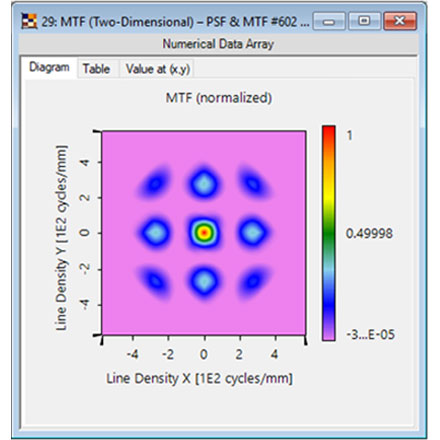|
Tuesday, January 11, 2022 |
|
Join us for a FREE Webinar
Next-Generation Optics Software: Trends in Technology
Tuesday, January 18, 2022 10:00 AM - 11:00 AM EST
|
|
Sponsored by
|

|
|

|
Physical optics calculation software typically provides a single solving program for Maxwell’s equations. Field solvers such as finite difference time domain (FDTD) or the finite element method (FEM) enable a user to model and design specific micro- and nano-optical structures, but by themselves these solvers do not provide a realistic system model. This is because of their high numerical effort, which tends to scale up with the size of a system. Consequently, ray optics software is the typical choice for system modelers.
But ray tracing is not enough to calculate the point spread function (PSF) and modulation transfer function (MTF) in a lens system. To compensate, ray-tracing software developers may include physical optics notions in their model-building programs. In this way, the central technology applied throughout the ray-tracing software addresses the connection between ray and physical optics at the exit pupil of an optical system model. Developments in modern optics and photonics have increased the demand for a more thorough inclusion of physical optics in systems modeling. One such example of a demanding system is AR/MR glasses, which include micro- and nano-optics, partially coherent sources, or a combination of all of these.
Similar to solving for PSF and MTF in ray-tracing software, adding physical optics considerations to any modeling program is often approached by asking how physical optics should be incorporated into ray optics software. But there are pitfalls to this approach. One problem is that it assumes one knows in advance where in an optical system physical optics treatment is needed. This introduces a risk of missing unforeseen and potentially important physical effects. But the main problem is one of principle: Light is represented by rays in ray optics and by electromagnetic fields in physical optics. In general, rays do not include all field information. For this reason, switching back and forth between ray optics and physical optics calculations is not suitable or practical for successful modeling.
Frank Wyrowski of LightTrans International introduces an alternative approach in this webinar: Starting from the more general model of physical optics, how can one identify and apply the generalization of ray optics inside the framework of physical optics? Wyrowski presents the modeling software that results from answering this question, showcasing how physical optics modeling can be made more practical and useful for advancing technologies.
Pictured: A simulation of a waveguide with a complex 2D exit pupil expansion. Courtesy of Frank Wyrowski.
Who should attend:
Engineers and R&D scientists working with optical systems modeling software who are interested in addressing the challenges of integrating physical optics with ray optics simulations. This webinar offers a nuanced perspective on optical modeling parameters, demonstrated with examples from applications that include fiber coupling, interferometry, AR/MR glasses, and diffusers.
About the presenter:
Frank Wyrowski is president of LightTrans International GmbH. He co-founded the company in 1999, as well as Wyrowski Photonics GmbH in 2014. Since 1996, he has also worked as a professor of technical physics and as head of the Applied Computational Optics Group at Friedrich Schiller University in Jena, Germany. His work as an entrepreneur, researcher, and educator is dedicated to developing fast physical optics-solving techniques, as well as software to address the increasing demand to supplement ray optics in modern optics and photonics design. His current R&D focuses include lightguides for AR and VR, light-shaping, microscopy, interferometry, fiber coupling, diffractive, and meta lenses; diffractive optical elements (DOEs) and holographic optical elements (HOEs); as well as freeform, micro-lens arrays, and physical optics theory.
About the sponsors:
Since 1999, LightTrans' products and services – including optical design software, optical engineering, training and consulting, as well as prototyping – have shortened or even enabled development cycles of innovative optical components and systems. All activities are based on the fast physical optics design software, “VirtualLab Fusion," which provides ray-tracing and physical optics field-tracing methods.
|
|
|
|
Date: Tuesday, January 18, 2022
Time: 10:00 AM - 11:00 AM EST
Space is limited. Reserve your Webinar seat now at: https://attendee.gotowebinar.com/register/7385683906340208912?source=Eblast
After registering you will receive a confirmation email containing information about joining the Webinar.
|
|
|
SYSTEM REQUIREMENTS
Operating System
Windows® 7 or later, Mac OS® X 10.9 or later, Linux®, Google ChromeTM OS
AndroidTM OS 5 or later, iOS® 10 or later
Web Browser
Google ChromeTM (most recent 2 versions)
Mozilla Firefox® (most recent 2 versions)
Mobile Devices
AndroidTM 5 or later
iPhone® 4S or later
iPad® 2 or later
Windows Phone® 8+, Windows® 8RT+
|
|
|
|
.: More from Photonics Media
|
|
|
|